Fishing The Salmon River New York: A Complete Guide
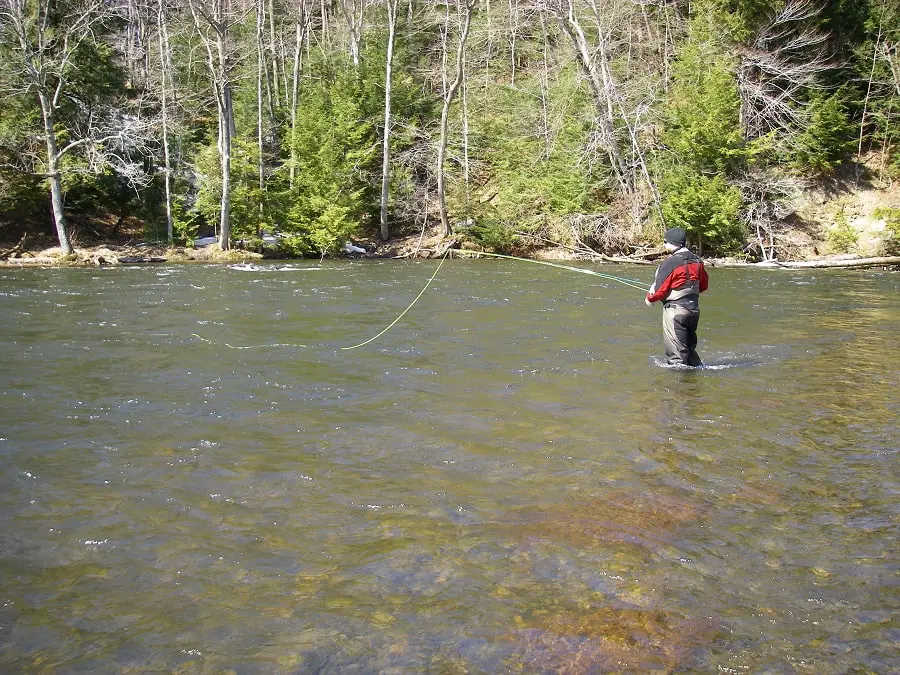
Fishing the Salmon River New York is known as a world-class river for steelhead and salmon. The Salmon River even has two records which include the world’s largest Coho Salmon.
Anglers can fish for steelhead, Atlantic salmon, Chinook salmon, Coho Salmon, large lake-run brown trout, and even smallmouth bass. The time of year will dictate which species you will catch the most.
World-Class Fishing On The Salmon River
The Salmon River in New York is undoubtedly one of the most coveted fishing destinations in the United States and arguably the best steelhead and salmon river in the East. I mentioned that it’s in New York State, so you do not confuse it with the Salmon River in Idaho.
The Salmon River has at least five sport fish species that anglers can find in the river at certain times of the year. There are also suckers, carp, and walleye.
The river runs for 17 miles, 12 of which have public fishing rights. The fishing zone starts at the Lighthouse Hill Reservoir to Lake Ontario, cutting its way through most of Oswego County and Pulaski City. See Fishing Pulaski NY: Access, Species and Best Methods for more.
Size Of Salmon River, NY
The Salmon River is considered one of the state’s larger rivers, averaging about 100 feet wide through most of the fishable water. Under normal flows, It is relatively shallow, with many rocky riffle sections averaging 2 to 5 feet and some pools ten feet or deeper.
This large river gives anglers plenty of room to spread out and fish, and it also allows the fish lots of room to fight.
Salmon River Water Flows And Clear water
Several dams in the Salmon River make up several large reservoirs, the most famous of which is operated by the Orion Power Company. Under their new licenses, these power companies have to maintain a minimum water flow in the river.
The impact of these regulations is that there is always enough water to encourage the fish to stay in the river. Even in the summer, when most rivers typically have very low water levels, the Salmon River still has enough water for the fish and for fish migrations.
Because the river is dam-regulated, it often flows clear even when high.
The ideal river flows for fishing along the banks of the Salmon River are from 350 cfs to 700 cfs. I have fished it as high as 1600 cfs, but fishing can become difficult and dangerous at these levels.
You may find the river over the banks and into the forest if you get there during high water. I fish the smaller branches and splits around the islands during these conditions. These sections can be perfect during high water.
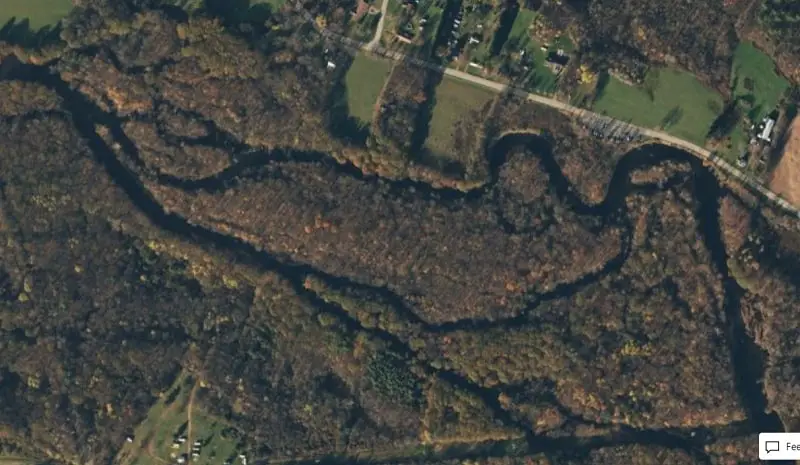
Prime water-flow conditions for shore fishing are anywhere from 350 to 700 cfs. Keep an eye on the flow as your trip approaches, and consider rescheduling if the river rises above 1600 cfs.
Another option which I have done with great success is to move to nearby Sandy Creeks when the salmon river is too high to fish.
Anglers in drift boats can fish effectively in higher water, but it can be challenging for fishermen working the banks.
Aggressive Stocking
The New York DEC has been stocking the Salmon River aggressively since the 1960s’. Today, the Department stocks hundreds of thousands of different fish species, with the most prominent ones being Chinook salmon, steelhead trout, Coho salmon, and brown trout.
There is also stocking of Atlantic Salmon and Skamania steelhead, which enter the Salmon River starting in June and throughout the summer months. These species, combined with some impressive smallmouth bass, have created a good summer fishery.
The DEC’s stocking efforts have provided anglers with fantastic fishing throughout the year, and this is another reason why fishing the Salmon River in New York is something you should consider.
Seeing that the river produces these stocked species in large quantities, days of 20-plus fish caught are not uncommon, and very large steelhead and salmon are caught every year.
In fact, the largest Coho salmon ever caught was from the Salmon River. This world record Coho weighed an impressive 33lbs. The record largest Great Lakes Chinook salmon also caught in the Salmon River was 47 lbs.
What to Expect When Fishing the Salmon River, NY
Spring and Fall: You can fish the Salmon River throughout the year, but the most rewarding fishing season is the fall salmon run from September to November, and Steelhead fishing from November to early May.
Summer Species: However, there are specific summer runs of Skamania steelhead and the Atlantic salmon.
Winter: Winter fishing can be excellent for steelhead as most of the river near the dam does not freeze.
Amenities: One of the best things is the abundant fishing amenities, from numerous access points to lodgings and some great restaurants, as well as many fly shops and tackle stores selling all the fishing equipment and gear an angler would need.
Fishing Guides: Additionally, many fishing guides offer boat trips on the river or walk trips along the banks. There are also charter boats that fish the mouth and Lake Ontario.
Fishing Pressure: The fishing pressure during some days in the fall or spring makes competition for the fish and the fishing spots almost unbearable. As a result, it is not uncommon for anglers to be too close to each other, a situation aptly called combat fishing.
Private Access: Fishing in the river’s private sections will require you to get special permission from the landowners. You may also have to pay a small fee to access these fishing spots, but this can be worth it when the public access areas are very busy. For private water fishing, check out Douglaston Salmon Run.
Fish Species Found in the Salmon River
Chinook (King) Salmon
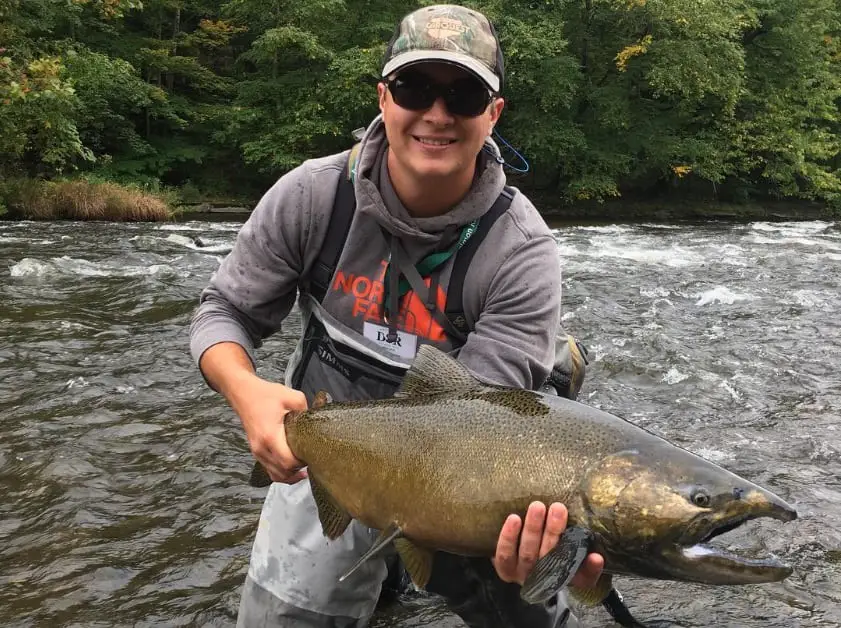
The Chinook salmon is by far the most prevalent salmon species in the Salmon River. This is hardly surprising, given that the DEC stocks about 3.2 million of these fish in the river annually.
The Chinook salmon averages 15-25 pounds.
With the Chinook having the largest runs and being the largest of all the fish species, they attract a lot of anglers to the area.
The fall runs are triggered by the rising water volumes from either release at the dams or from heavy downpours. Salmon also enter the rivers based on falling river temperatures and cool nights.
The Chinook salmon spawn in the fall months of late September, October, and early November.
Some immature Chinooks can be caught near the river mouth in the spring by anglers casting lures or by boat anglers trolling.
If Chinook fishing is your thing and you want to know the methods, setups, baits, and flies used by river fishing guides, check out my page, Great Lakes Salmon Fishing: River Fishing Methods
Coho Salmon
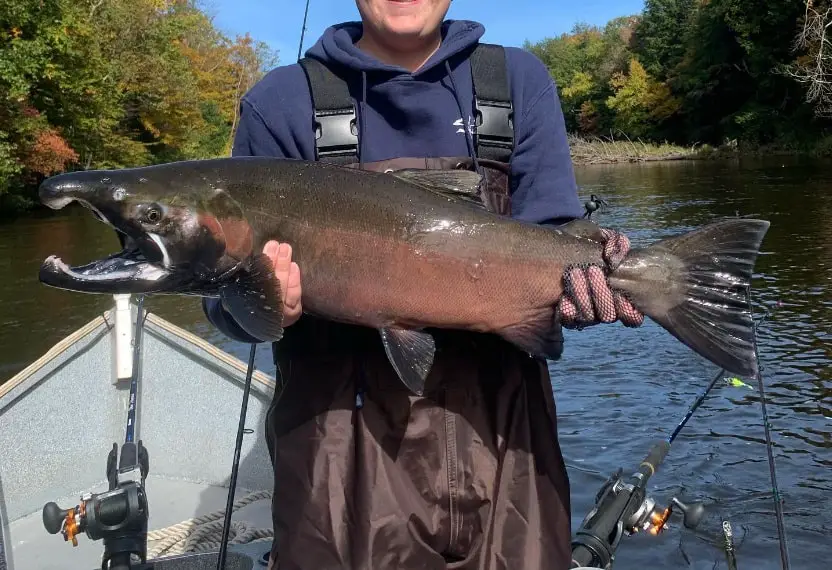
After the Chinook salmon, the Coho salmon are the largest salmon population in the Salmon River. The DEC stocks about 250,000 of these fish in the river annually, usually in spring.
The Coho are in the river starting in September, peaking in October, and are gone by December. I use all the same methods, flies, and baits for fishing for Coho as I do when fishing and guiding for Chinook Salmon.
Atlantic Salmon
The Atlantic salmon may have been the fish that gave the Salmon River its name and now the DEC has been trying to revive the Atlantic population since the 60s’.
Atlantic salmon migrate into the river starting in June and July and will continue into the fall, providing incidental catches for lucky anglers.
I use the same steelhead fishing methods for catching Atlantic salmon.
Steelhead
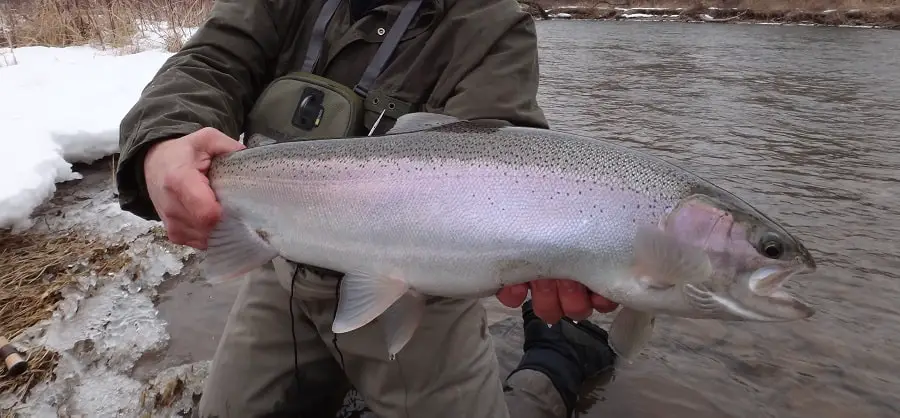
Each year, the Salmon River gets two different steelhead runs: The Skamania strain, which migrates up the river in the summer.
And the Washington winter-run steelhead, which starts migrating the river in mid-October, through the winter, and in the spring. Both strains of steelhead can remain in the river until early May.
The steelhead usually spawns in March and April.
An adult steelhead can be anywhere between three and five years old, and an average steelhead is between 7 and 12 pounds. Some steelhead will be caught in the Salmon River over 20 pounds.
According to river guides and local anglers, some of the best steelhead fishing is during the winter months when the steelhead is held in deep pools, and the crowds are gone.
Knowing how to fish steelhead in the winter is important. I discuss fishing for steelhead during all seasons, as well as the best methods and the best baits on my page, Great Lakes Steelhead Fishing: Proven Methods And Tips.
Brown Trout
There is a decent population of lake-run brown trout, which can average 5 to 7 pounds, and some grow to over 20 pounds. At times, there are lots of browns in the river. The brown trout migrate and spawn in the river from September to November.
Many brown trout will leave the river after they spawn, but some will hold over in the river and can be caught all winter and spring.
I use the same steelhead methods to catch brown trout in the river since they will feed on the same things and hold in the same water as the steelhead will.
Fishing Seasons in the Salmon River, NY
There are four seasons of fishing on the Salmon River, with spring and fall being the best times.
Fall Fishing
Fall is one the best times to fish the Salmon River because there are a ton of fish in the river at this time.
The river is usually heavily populated with steelhead, Coho salmon, Chinook salmon, brown trout, and also anglers. Yes, it gets very busy during the salmon run, but the crowds seem to lessen once the Chinook salmon are gone and the weather gets colder.
Pro Tip: For less fishing pressure, try to hit the river during deer hunting season, when many anglers leave the river and head to the bush.
The steelhead, in particular, are aplenty at this time because they are actively feeding on salmon eggs, minnows, and aquatic insects.
Winter Fishing
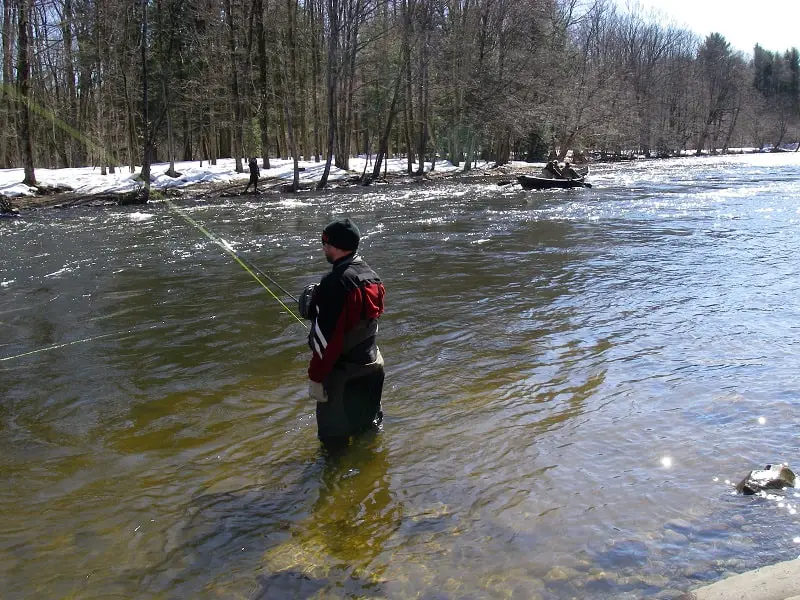
Winter is steelhead time, and it can be some of the best fishing on the Salmon River. The Salmon River is a tailwater fishery, so most of it rarely freezes, and water temps don’t dip too low.
I scale down bait and fly sizes and fish deeper, slower water for holding fish. I discuss these methods on my page, Winter Steelhead Fishing: Tips And Tactics Of Expert Guides.
If you like fishing in solitude and don’t mind working a little harder, and you use my winter fishing tactics, winter fishing in the Salmon River can be highly rewarding.
Also, winter fishing can be tough on toes and fingers, keeping many anglers off the river. Have you ever wondered how river guides can be out in that cold day after day? I provide my tips and tricks that guides use to stay warm, dry, and comfortable on my page Fishing In The Winter – Stay Warm With These 10 Tips
Spring Fishing
The mild weather conditions in the spring make it one of the best times to fish the Salmon River. You will find decent amounts of steelhead in the river that are both ravenous and aggressive and willing to feed after the long winter.
Additionally, many steelhead will feed heavily after they finish spawning and as they slowly work their way back to the lake.
The fish’s heavy movements and hunger make them highly susceptible to striking your baits. You may also find some Brown trout and some Atlantic Salmon in the Salmon River at this time.
Summer Fishing
Summer is typically not the best time to fish the Salmon River. This is because the water levels at this time are low, and the water temperatures are too warm for the fish.
However, the Salmon River has small and sporadic summer runs of Skamania steelhead, brown trout, and Atlantic Salmon. You may also find some smallmouth bass in the river in summer.
The Best Fishing Methods For The Salmon River, NY
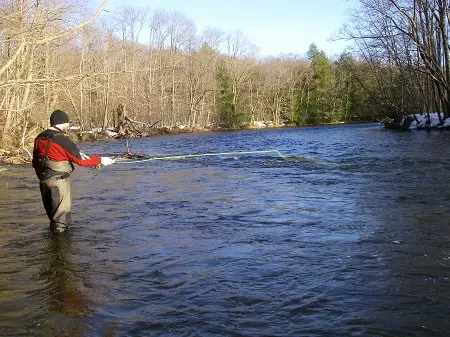
Fly Fishing
This is one of the most popular fishing methods for steelhead, Chinook salmon, and Coho salmon. Most fly fishing is done by drifting flies or nymphs under an indicator.
Guide Tips: Use weighted flies to ensure your fly stays in the strike zone throughout the entire drift. Additionally, use brightly-colored flies in poor lighting or when the water is dirty to increase their visibility. You should also consider wearing polarized glasses to seek the fish first before casting.
You can see how the guides do it at Fly Fishing For Steelhead: Great Lakes Style
Spey Fishing
Another fly fishing method that is very popular on the Salmon River is Spey fishing. The Salmon River is wide, has a good flow, and has the right depth for Spey fishing.
You can Spey fish for all the migratory species using the methods I discuss on my page Spey Fishing On Great Lakes Rivers
Streamer Fishing
If you enjoy catching big fish with a fly rod, streamer fishing is another good method.
Here, you will cast large flies, known as streamer flies, across the river at a 45-degree angle and actively retrieve them using twitching motions to impart an erratic swimming action.
For streamer fishing success, choose a 9-foot, 8 or 9-weight fly rod with a floating line with or without a sink tip.
Also, be sure to use large flies that resemble baitfish for the best results.
Drift Fishing
Drift fishing requires some practice to perfect, but it can be very effective on big rivers like the Salmon River, and I see both anglers and river guides using it frequently. For it to work, your presentation must be as natural as possible. For more on this method, check out my page: Drift Fishing
Similar to drift fishing, and a method I use a lot in pocket water and riffles is Bottom Bouncing.
Where To Fish In The Salmon River, New York
The Salmon River has numerous fishing spots from the mouth to the Lighthouse Hill Reservoir dam, preventing fish from traveling upstream. As such, the fish are trapped in that 17-mile downstream section, making this the ideal fishing location.
It is important to note that some fishing spots are on private land. As such, you will need the landowner’s permission to fish here, and you may also have to pay a small fee.
One of the most lucrative private fishing spots on the Salmon River is the Douglaston Salmon Run, popularly known as the DSR. Here, you will find some of the biggest steelhead and King salmon. However, you may have to pay as much as $100 at peak times to fish here.
If you don’t have extra money for fishing on private property, you can still find many decent spots on the 12-mile strip of the river with public fishing rights. It is best to start your search downstream and then move upstream if you don’t find good runs. Some of the best downstream fishing locations are:
- Pine Grove Boat Launch – At the end of Pine Grove Road at the lake.
- Port Ontario – Parking and Access on the North-East side at Rt 3 and Riverside drive
- Douglaston Salmon Run – Private Section
- Black Hole – Off of River View Drive on the East side.
- Long Bridge Pool (Staircase Access and Parking) – South Jefferson Street in Pulaski.
- Short Bridge Pool – Pulaski Fishing Spot – Town Hole
- Ball Park Hole West – East Side Parking and Haldane Community Center Access
For upstream fishing (Upstream Of Pulaski)
- Compactor Pool
- Fishermans Pool
- Fishing Museum Access
- Sportsman Pool and Parking
- Pineville Pool and Launch
- Trestle Pool and Parking
- Ellis Cove Parking
- Altmar Pool East Parking and Alternate Parking
- Lower Fly Fishing Section West Parking
- Upper Fly-Fishing Section Parking 2
Fishing Regulations For The Salmon River, NY
The two major regulations you must adhere to are the Lake Ontario Tributary Laws and the DEC Regulations. The most prominent rules that every angler must follow or risk getting a ticket include:
- Be aware of the Fly Fishing Only sections and use the required gear there
- You must possess a license. Even if you are only assisting another angler in bringing in the fish, you must be duly licensed. You can get your Salmon River fishing licenses here.
- From the 15th of August to the 14th of April, you must not fish the Salmon River at night. You can only start angling half an hour before sunrise, and you must be out of the water half an hour after sunset.
- The daily catch limit is three fish a day, both trout and salmon.
- It is illegal to herd, stone, or kick fish to boost your catch.
- You must use the proper fishing gear. For instance, hooks must have a single point and not be more than half an inch long. Additionally, you must not use treble hooks during salmon runs.
Regulations may change, so for a more detailed look at the regulations, be sure to visit the DEC website
Fishing Amenities At The Salmon River, New York
Accommodation
You will find many accommodation options near the Salmon River, New York. Whether you prefer to stay at a hotel, motel, lodging, camping ground, or bed and breakfast, rest assured you will find one near the hotel.
However, you should make your reservations early in advance, especially if you intend to go fishing during the peak season. In fact, it is best to make your reservations as early as one year before to avoid missing out on a place to sleep.
To find the best lodgings near Salmon River, New York, be sure to visit this site.
Fishing Guides
There are many guides in the area, but we recommend doing your research to find the best guides.
However, beware that some guides only offer drift boat trips, others only offer wading trips, while others offer both kinds of trips. Be sure to confirm with your guide before booking to ensure your trip is successful.
Also, make sure your guide uses the methods of fishing you want.
Many guides offer steelhead and brown trout trips from October to May when the rivers have the best runs. However, if you wish to catch Coho and Chinook salmon, you should book far in advance for your trip in September or October.
Fishing Stores
Just as with accommodation and fishing guides, the Salmon River area has plenty of fly shops and fishing stores. Whether you need baits, lures, lines, rods, reels, or any fishing gear, rest assured that there is a fishing supplies store nearby where you will find the items you need. Some of the leading stores include:
- Fat Nancy’s Tackle Shop
- Pineville Sporting Supply
- All Seasons Sports
- Whitaker’s Sport Shop and Motel
- Woody’s Tackle Shop and General Store
Fishing Tips For The Salmon River, NY
Dress Warmly
Because the best steelhead and salmon runs get to the river during the colder months, it is best to dress warmly for your fishing trip. Consider having a wool base, a mid-layer, and a bottom-down jacket to stay warm throughout your fishing session.
Additionally, you might want to carry an extra jacket in case the weather gets chillier than you anticipated.
Practice Proper Fishing Etiquette
The Salmon River experiences some of the highest fishing pressure in the country, particularly during peak fishing seasons. As such, anglers need to practice the highest standards of fishing etiquette to make the experience pleasant for everyone.
Some courteous behavior to display during your fishing trip includes:
- Take home a small number of fish; if you catch more fish than you need, release them into the water
- Clean up after yourself – Garbage is a big problem on this river.
- Maintain silence, especially when fishing near a residential area
- Seek permission before fishing on private property
- Don’t park on a landowner’s lawn or obstruct other people’s driveway
- Don’t clean your catch near the stream
You have just read the shortened and revised article. See the in-depth full article HERE.
Tight Lines,
Graham
